Shoreline Stabilization Techniques
The shoreline is an important and sensitive area that connects the aquatic world with the adjacent upland. These “edge” areas provide essential habitat for fish, amphibians, reptiles, birds, insects, and other wildlife. They also set the stage for good water quality, as the vegetation and natural forest duff layer along the shore infiltrate pollutant- and silt-laden stormwater runoff, keeping lake water clean.
Shoreline stabilization projects should be used to address erosion and stability issues – permits will not be issued for projects that are solely decorative in nature or aimed at reclaiming land lost to erosion.
Preferred Methods
Preferred methods include shoreline stabilization methods that mimic the properties of a natural shoreline. Most natural shorelines have gentle, gradual slopes (2:1) or shallower. Natural materials including plants, natural stone, and biodegradeable landscaping fabric are preferred materials to use to stabilize a shoreline over time.
Many of these methods are highlighted in the Vermont Bioengineering Manual, and below.

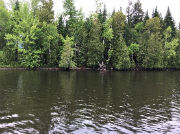
Preserving the natural shoreline: Natural shorelines are diverse and contain live vegetation, stumps, rotting logs, and rocks of many sizes. This diversity allows a shoreline to be resilient against wave, wind, and ice action. Trees, shrubs, and native perennials have complex root systems which bind soils together, as well as foliage-covered branches to prevent rain and wind-related erosion. Turf grass seeded for lawns has minimal root structure and provides no below-ground stability. Preserving a naturally vegetated shoreline is an easy first step towards preventing erosion and land loss. In addition to providing erosion control, vegetation infiltrates stormwater runoff coming off roads, driveways, and rooflines further upland. Leaning trees drop insects into the water, providing an important food source for fish. Coldwater fish species benefit from the shading and cooling effect provided by overhanging trees and shrubs.
Planting vegetation along the shoreline: Minimize the amount of lawn-to-lake by planting native trees, shrubs, and perennials along the shoreline. In addition to being well-adapted to the soils and local climate, native plants are the preferred food for the region’s wildlife and pollinator species. Planting native vegetation helps to support biodiversity, making the shoreline more resilient to aggressive invasive species. Creating a “no mow zone” along the edge of the shoreline is a simple and cost-effective start to establishing native vegetation at the shoreline. The Vermont Bioengineering Manual provides information about establishing vegetated buffers and about regrading a steep slope to improve slope stability.
Bioengineering methods: Bioengineering combines native plants with natural materials such as fiber coir rolls, encapsulated soil lifts, live staking, and other biodegradable materials to stabilize slopes and eroded areas. As living shorelines, they can adapt to a changing environment and become more stable over time as root systems become established. Artificial less preferred shoreline stabilization measures often fail over time and require continual long-term maintenance. Most importantly, all bioengineering methods provide an additional benefit of restoring fish and wildlife habitat in conjunction with providing shoreline stability.
Live staking: Live stakes are cuttings from woody shrubs that are tamped directly into the ground, and over time, will root and grow on their own. This method is an inexpensive and easy option for landowners, and is used alone or in conjunction with other bioengineering methods in more heavily eroded areas. The stakes root most readily when cut and planted in the late fall, when the parent plant is dormant. Native willows and dogwoods are most commonly used for live staking. More details about live staking are available at this link.
Fiber coir rolls: Coir rolls are made of densely packed coconut or other biodegradable fibers. The coir rolls are placed in a pre-dug shallow trench, then securely staked in place, forming the toe of a gently sloped shoreline leading upland. Vegetation is planted in, around, and on top of the fiber coir rolls. The fiber coir rolls provide a durable base that retains moisture while plants become established; they will eventually biodegrade as roots take hold. More details about fiber coir rolls are available at this link.
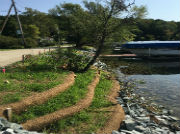
Encapsulated soil lifts: This technique involves the “encapsulation” of soil in biodegradable blankets that are then folded back into layers, or lifts. Using a stone toe as protection, the lifts are stacked up a bank to create a gentle slope, then seeded or planted with native vegetation. Encapsulated soil lifts are especially effective in heavily eroded or steeply sloped areas. Like fiber coir rolls, the soil lifts provide a stable growing base while plants take root. More details about encapsulated soil liftsare available at this link.
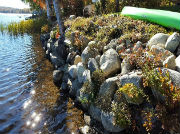 Stone and vegetation or "vegetated rip rap": In unstable areas where vegetation alone is not sufficient to stop erosion, a “rocks and roots” approach may be more appropriate. Rip rap and other dry-laid stone provides solid reinforcement against ice and wave action, while still allowing for the infiltration of runoff from further upland. Biodegradable filter fabric and a layer of clean crushed gravel placed behind the rock will help prevent further loss of sediment from the bank. Vegetation planted among the rocks and at the top of the bank will greatly increase the long-term stability of the shoreline while providing wildlife habitat. It is important to set the bank at a gentle slope (at least 2:1 preferred), to deflect ice and allow vegetation to establish.
Stone and vegetation or "vegetated rip rap": In unstable areas where vegetation alone is not sufficient to stop erosion, a “rocks and roots” approach may be more appropriate. Rip rap and other dry-laid stone provides solid reinforcement against ice and wave action, while still allowing for the infiltration of runoff from further upland. Biodegradable filter fabric and a layer of clean crushed gravel placed behind the rock will help prevent further loss of sediment from the bank. Vegetation planted among the rocks and at the top of the bank will greatly increase the long-term stability of the shoreline while providing wildlife habitat. It is important to set the bank at a gentle slope (at least 2:1 preferred), to deflect ice and allow vegetation to establish.
More details about establishing a rock toe are available at this link.
Less Preferred Methods
Solid vertical walls are "hardscaping" methods used to stabilize a shoreline, whether they are made of concrete, railroad timbers, or gabion baskets, these walls create a sterile disconnect between the water and upland areas, and eliminate the littoral habitat needed by fish and wildlife. By disrupting the natural transition between the two zones, vertical retaining walls physically block turtles, frogs, waterfowl and other wildlife that require free access to both land and water as part of their life cycle.

Retaining walls: Vertical retaining walls are mistakenly perceived to be more stable than the other methods described above. However, retaining walls do not allow for the absorption of incoming wave energy – instead, waves reflect off the hard surface, resulting in scouring and erosion elsewhere around the wall, undermining the walls integrity at the water’s edge and along the sides of the wall. They are costly to install and have a high failure rate over time. Retaining walls are not encouraged for shoreline stabilization, and new retaining walls are generally not approved.
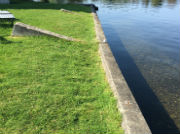
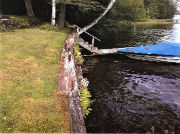
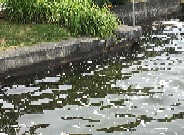
Do I Need a Permit for my Shoreline Stabilization Project?
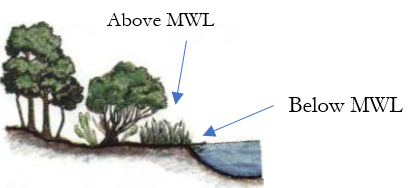
Projects extending below mean water level AND proposing the removal of vegetation or the creation of new impervious surface will require both a Lake Encroachment Permit and Shoreland Protection Permit.
Will the project be at or extend below the mean water level (MWL)?
- If Yes: A Lake Encroachment Permit is required
Will the project require the removal of vegetation or the creation of new impervious surface within 250 feet from mean water level?
- If Yes: A Shoreland Protection Permit is required
Contact a Lake and Shoreland Permit Analyst with questions about permitting your shoreland stabilization project. The Vermont Lake Wise Program and the Northwest Regional Planning Commission's Shoreline Stabilization Handbook can provide additional information.
